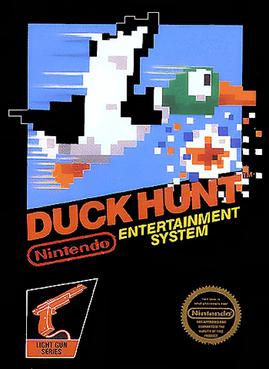
Duck Hunt is a 1984 light gun shooter video game developed and published by Nintendo for the Nintendo Entertainment System (NES) video game console and the Nintendo VS. System arcade hardware. The game was first released in April 1984, in Japan for the Family Computer (Famicom) console and in North America as an arcade game. It became a launch game for the NES in North America in October 1985, and was re-released in Europe two years later.

Super Mario Kart is a kart racing game developed and published by Nintendo for the Super Nintendo Entertainment System (SNES). The first game in the Mario Kart series, it was released in Japan and North America in 1992, and in Europe the following year in 1993. Selling 8.76 million copies worldwide, the game went on to become the fourth best-selling SNES game of all time. Super Mario Kart was re-released on the Wii's Virtual Console in 2009, on the Wii U's Virtual Console in 2013, and on the New Nintendo 3DS's Virtual Console in 2016. Nintendo re-released Super Mario Kart in 2017 as part of the company's Super NES Classic Edition.
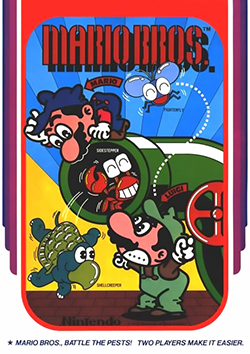
Mario Bros. is a platform game developed and published by Nintendo as an arcade video game in 1983. It was designed by Shigeru Miyamoto and Gunpei Yokoi, Nintendo's chief engineer. Italian twin brother plumbers Mario and Luigi exterminate creatures, like turtles (Koopas) and crabs emerging from the sewers by knocking them upside-down and kicking them away. The Famicom/Nintendo Entertainment System version is the first game produced by Intelligent Systems. It is part of the Mario franchise, but originally began as a spin-off from the Donkey Kong series.

Balloon Fight is an action video game developed by Nintendo and HAL Laboratory and published by Nintendo. The original arcade version was released for the Nintendo VS. System internationally as Vs. Balloon Fight, while its Nintendo Entertainment System counterpart was released in Japan in 1985 and internationally in 1986.
Super Smash Bros. is a crossover platform fighting game series published by Nintendo. The series was created by Masahiro Sakurai, who has directed every game in the series. The series is known for its unique gameplay objective which differs from that of traditional fighters, in that the aim is to increase damage counters and knock opponents off the stage instead of depleting life bars.
The Virtual Console is a line of downloadable video games for Nintendo's Wii and Wii U home video game consoles and the Nintendo 3DS family of systems.

Samurai Warriors: Katana is an action video game set in feudal Japan and is based upon the Samurai Warriors series by Koei and Omega Force, a spin-off of the Dynasty Warriors series. The game was revealed for the Wii at Nintendo's pre-E3 conference under the name "Sengoku Action".
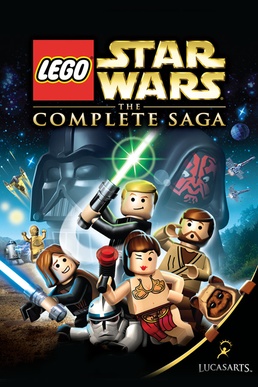
Lego Star Wars: The Complete Saga is a Lego-themed action-adventure video game based on the Lego Star Wars line of construction toys. It is a combination of the game Lego Star Wars: The Video Game (2005) and its sequel in 2006, which span the first six episodes of the Skywalker Saga. The game was announced by LucasArts on 25 May 2007 at Celebration IV and was released for the Xbox 360, PlayStation 3, Wii, and Nintendo DS on 6 November 2007 in North America. The game was later released on Microsoft Windows on 13 October 2009, macOS on 12 November 2010, iOS on 11 December 2013, and for Android on 1 January 2015. The game was a critical and commercial success.

Mario Kart Wii is a 2008 kart racing game developed and published by Nintendo for the Wii. It is the sixth installment in the Mario Kart series, and was released in April 2008. Like its previous installments, Mario Kart Wii incorporates playable characters from the Mario series, who participate in races on 32 different race tracks using specialized items to hinder opponents or gain advantages. The game features multiple single-player and multiplayer game modes including two to four person split screen. Online multiplayer was supported until the discontinuation of Nintendo Wi-Fi Connection in May 2014. Mario Kart Wii uses the Wii Remote's motion-controls to provide intuitive and conventional steering controls. Each copy of the game was bundled with the Wii Wheel accessory to augment this feature and mimic a steering wheel.

Lego Indiana Jones: The Original Adventures is a 2008 Lego-themed action-adventure video game developed by Traveller's Tales and published by LucasArts. Based on the Indiana Jones media franchise and the eponymous Lego Indiana Jones toy line. It follows the events of the first three Indiana Jones films: Raiders of the Lost Ark, The Temple of Doom, and The Last Crusade. It was released for Microsoft Windows, Nintendo DS, PlayStation 2, PlayStation 3, PlayStation Portable, Wii, Xbox 360, and Mac OS X.

Super Smash Bros. Brawl is a 2008 crossover fighting game developed by Sora Ltd. and Game Arts and published by Nintendo for the Wii. The third installment in the Super Smash Bros. series, it was announced at a pre-E3 2005 press conference by Nintendo president Satoru Iwata. Masahiro Sakurai, director of the previous two games in the series, assumed the role of director at Iwata's request. Game development began in October 2005 with a creative team that included members from several Nintendo and third-party development teams. After delays due to development problems, the game was released worldwide in 2008.

Super Smash Bros. Melee is a 2001 crossover fighting video game developed by HAL Laboratory and published by Nintendo for the GameCube. It is the second installment in the Super Smash Bros. series. It features characters from Nintendo video game franchises such as Mario, The Legend of Zelda, Star Fox and Pokémon, and Donkey Kong among others. The stages and gameplay modes reference or take designs from these franchises as well.
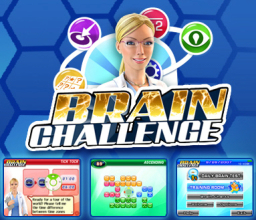
Brain Challenge is a mental exercise video game, featuring "brain exercise puzzles". The game was developed by Gameloft Beijing for mobile phone and iPod and released on September 5, 2007. In 2008 was followed by a Nintendo DS version on January 8, an Xbox Live Arcade release on March 12, and a PlayStation 3 launch on November 27. The N-Gage 2.0 version was released on the day of the service's launch, April 3, 2008. A version for WiiWare was released in autumn 2008 on all three regions. The Wii version also uses Miis for the players profile. OnLive also had launched their new streaming game platform with Brain Challenge on July 27, 2010. The game was released for Mac OS X in January 2011.

Bomberman Blast is an action game developed and published by Hudson Soft for the Wii and WiiWare as part of the Bomberman franchise. The game was released as two versions: a fully featured retail release and a WiiWare version known as Wi-Fi 8-Nin Battle Bomberman. The retail version was released in Japan on September 25, 2008, while the WiiWare version was released on September 30, 2008. The WiiWare version was released in Europe on September 12, 2008, and in North America on September 29, 2008.

F1 2009 is a video game based on the 2009 season of the Formula One motor racing series. It was released on the Wii and PlayStation Portable in 2009 on 16 November in North America, 19 November in the PAL region and 20 November in the United Kingdom. The game was also released on iOS on 14 December for £6.99. The PlayStation Portable version was also available as a download from the PlayStation Store from 16 November.
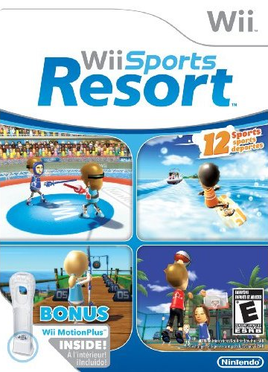
Wii Sports Resort is a 2009 sports simulation video game developed and published by Nintendo for the Wii video game console and is the sequel to Wii Sports. It is one of the first Wii games to require the Wii MotionPlus accessory, which was bundled with the game. Wii Sports Resort was first announced at E3 2008 and was released in Japan on June 25, 2009, and in nearly all other regions the following month. While Wii Sports Resort was first released as a stand-alone title, it was later bundled with newer Wii consoles alongside Wii Sports.

Tetris Party is a puzzle video game by Hudson Soft for WiiWare. An installment of the Tetris series, the game supports the use of Miis and the Wii Balance Board, and features both local and online multiplayer in addition to several single-player modes unique to the game.

GoldenEye 007 is a 2010 first-person shooter video game developed by Eurocom and published by Activision for the Wii, with a handheld version for Nintendo DS developed by n-Space. It is a modern reimagining of the 1995 James Bond film GoldenEye as well as a remake of the 1997 video game of the same name, developed for the earlier Nintendo 64 console. The game was officially announced by Nintendo at their E3 2010 conference presentation. The game was released on 2 November 2010 in tandem with another James Bond game, Blood Stone, which was also released for the DS, but not the Wii. Nintendo, the publisher of the Nintendo 64 game, published the Wii version in Japan the following summer, where it remains Wii-exclusive. It was the fifth James Bond game developed by Eurocom and their second under Activision, after the PlayStation 2 version of 007: Quantum of Solace two years prior.
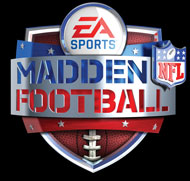
Madden NFL Football is a sports video game for the Nintendo 3DS which was developed by EA Sports. The game was developed by EA Sports from North Carolina in Raleigh. First images of the game were shown by IGN in February 2011. The game was released as a launch title for the Nintendo 3DS on March 22, 2011, in North America.
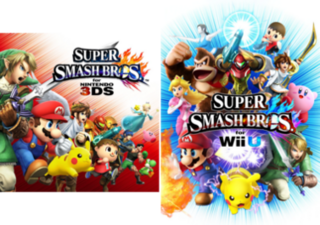
Super Smash Bros. for Nintendo 3DS and Super Smash Bros. for Wii U, both commonly referred together as Super Smash Bros. 4, are 2014 crossover platform fighter video games developed by Bandai Namco Studios and Sora Ltd. and published by Nintendo for the Nintendo 3DS and Wii U video game consoles. It is the fourth installment in the Super Smash Bros. series, succeeding Super Smash Bros. Brawl. The Nintendo 3DS version was released in Japan on September 13, 2014, and in North America, Europe, and Australia the following month. The Wii U version was released in North America, Europe, and Australia in November 2014 and in Japan the following month.

















